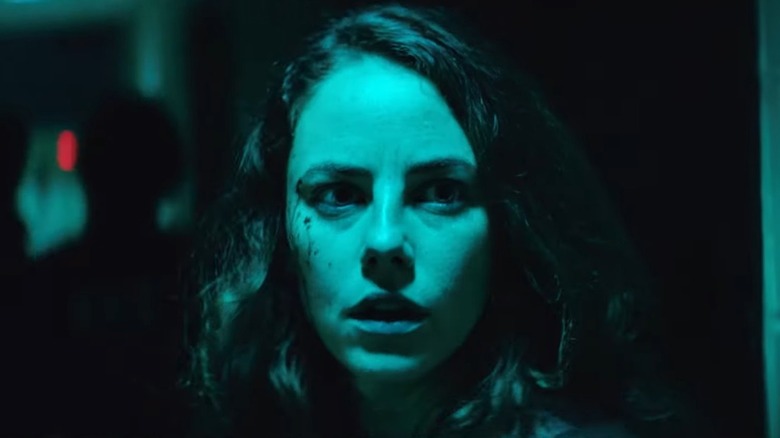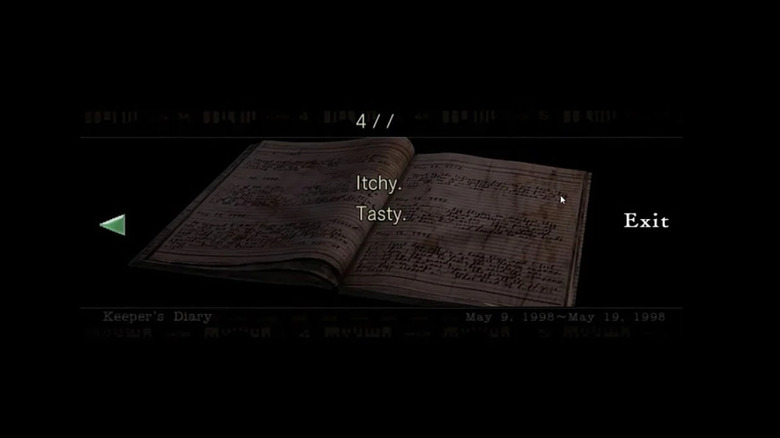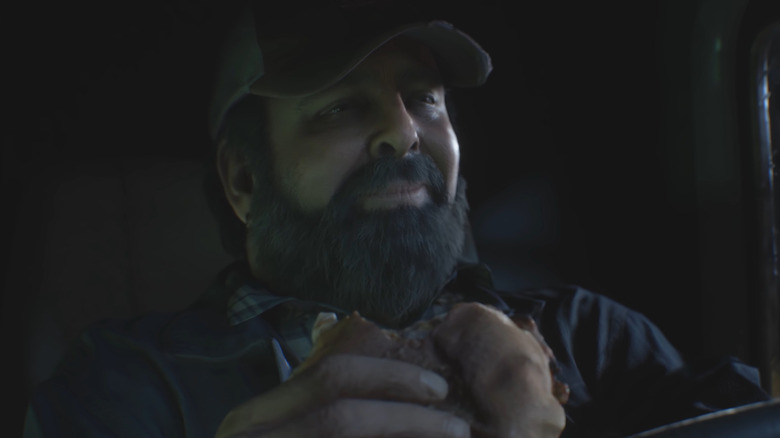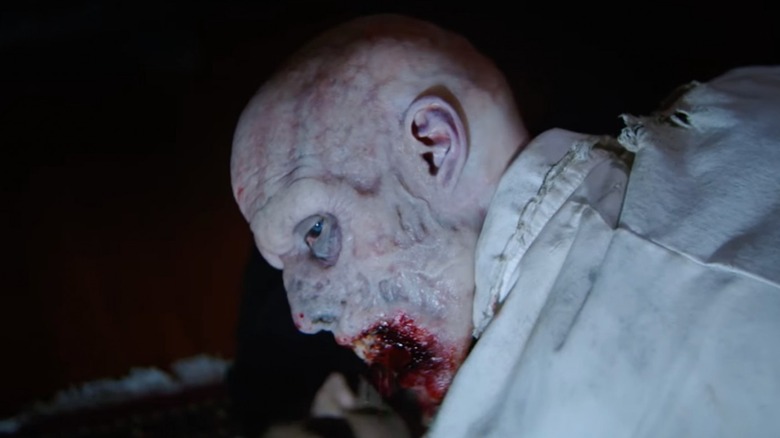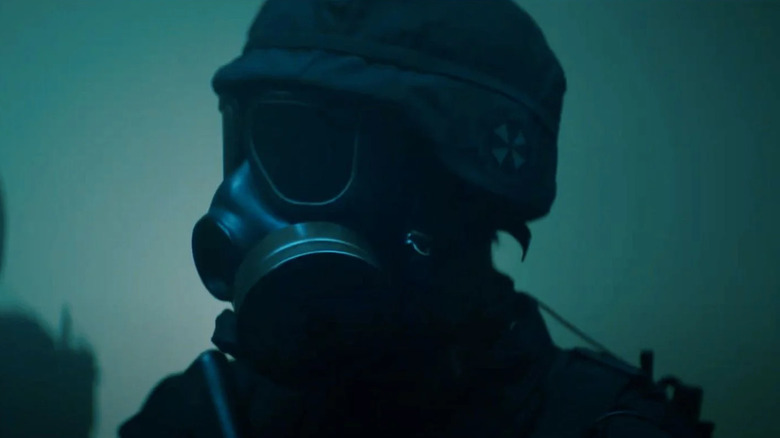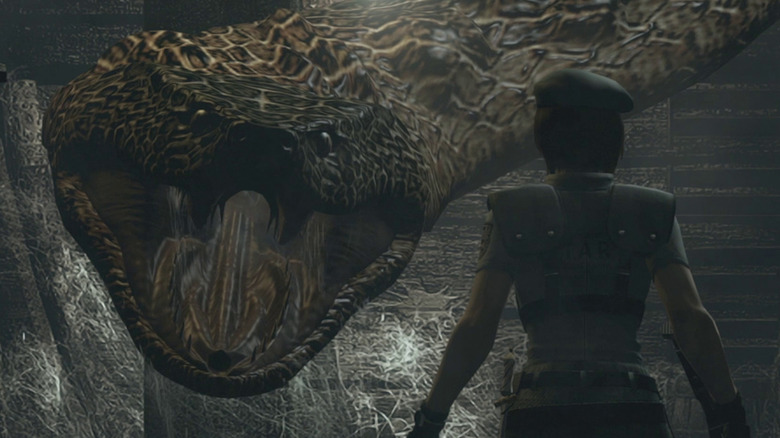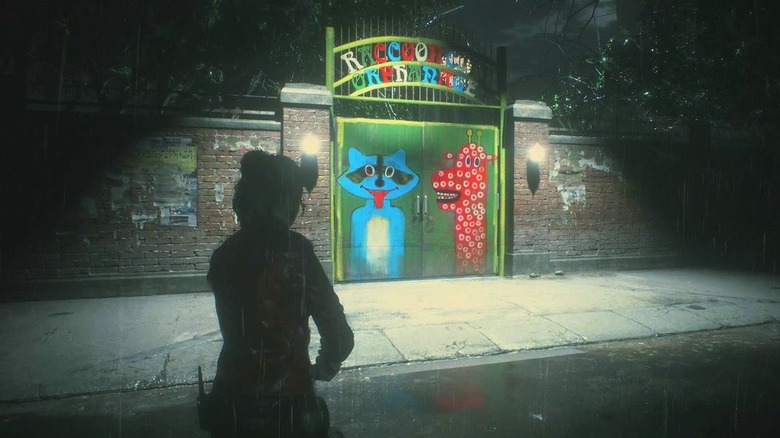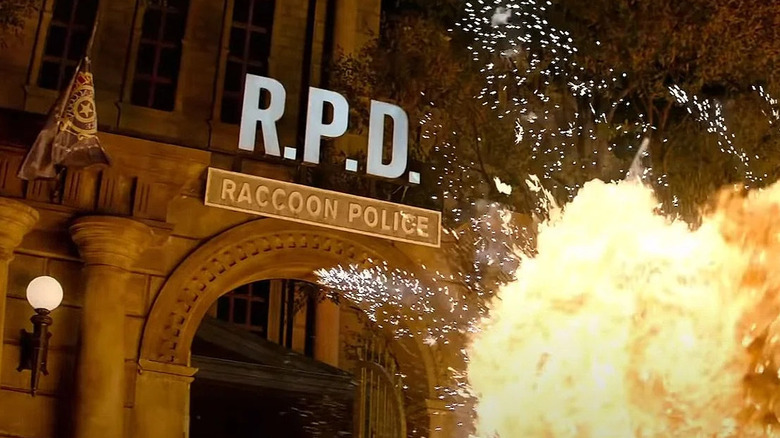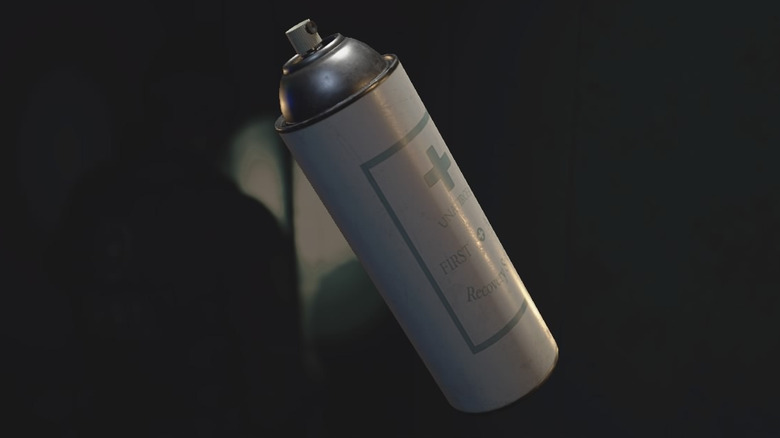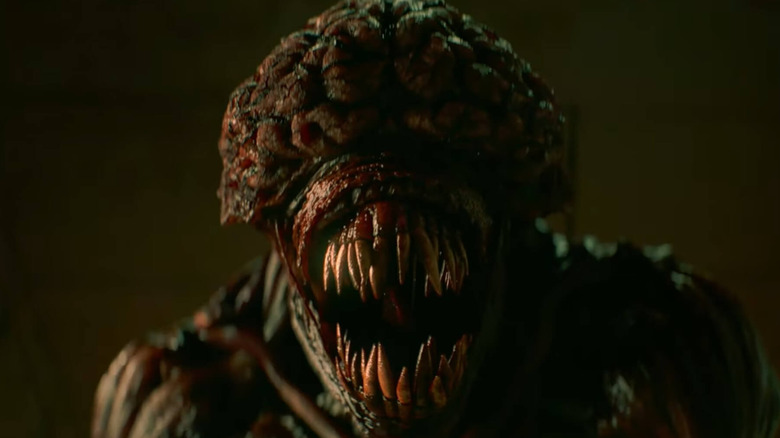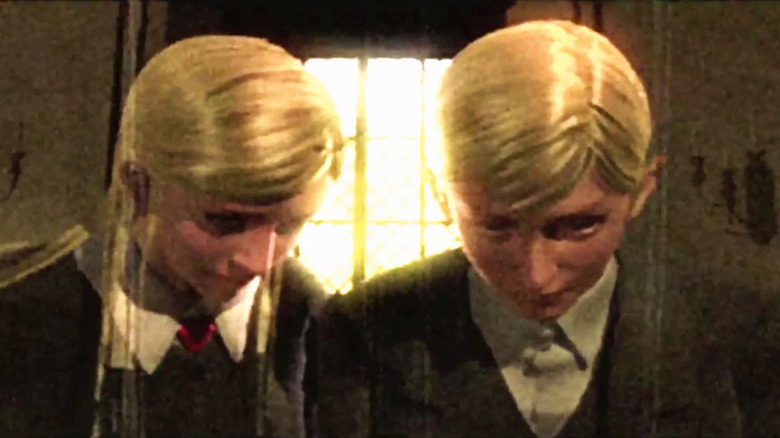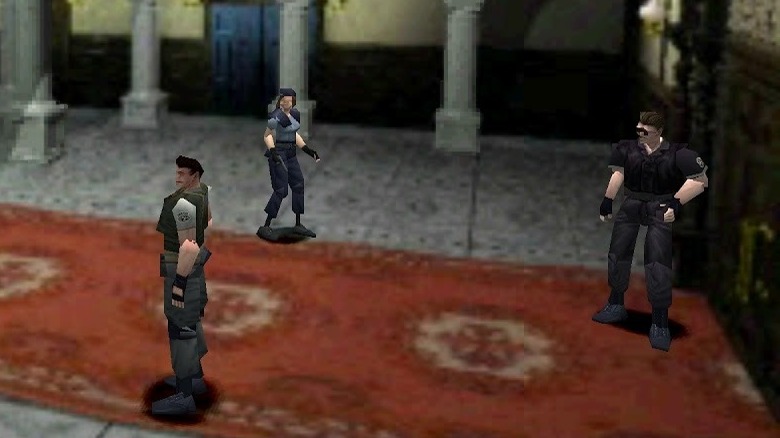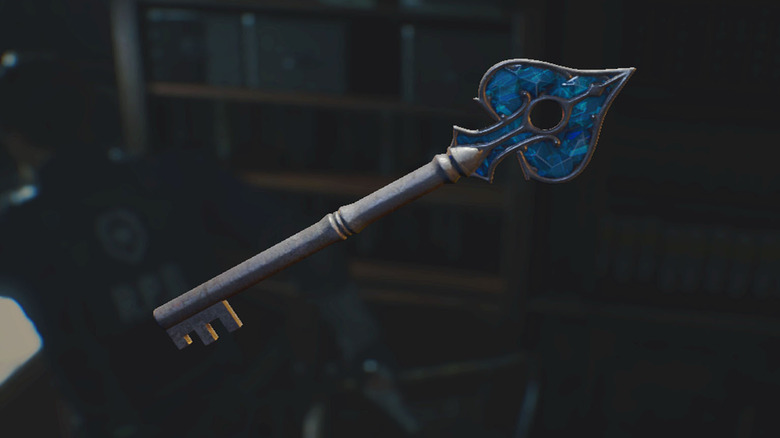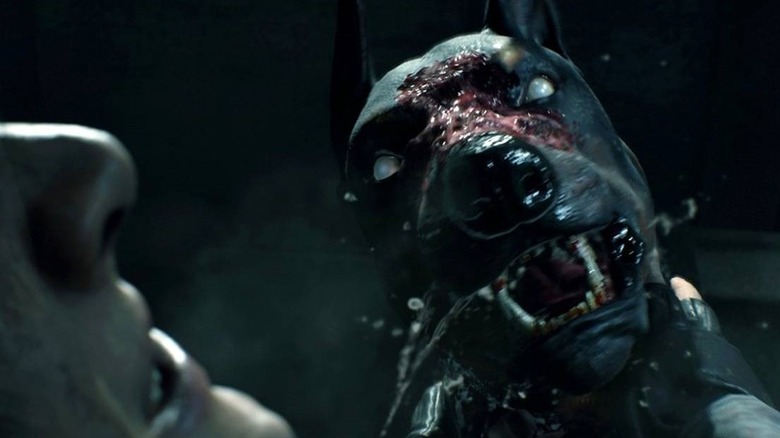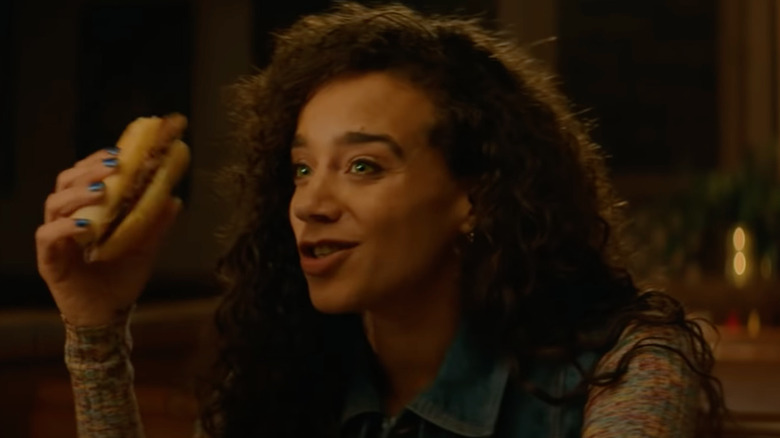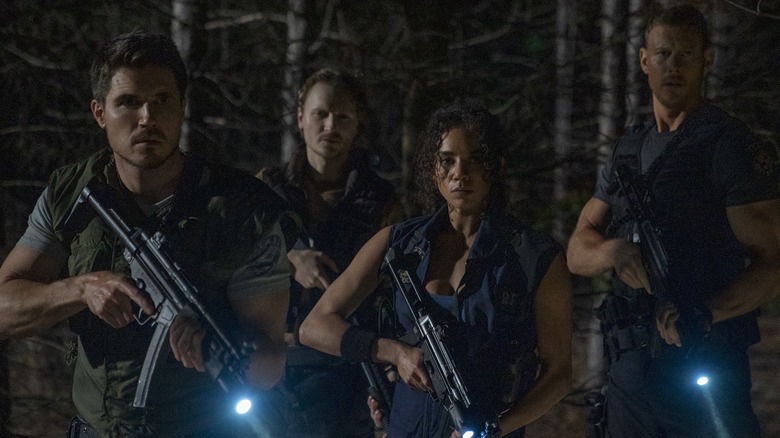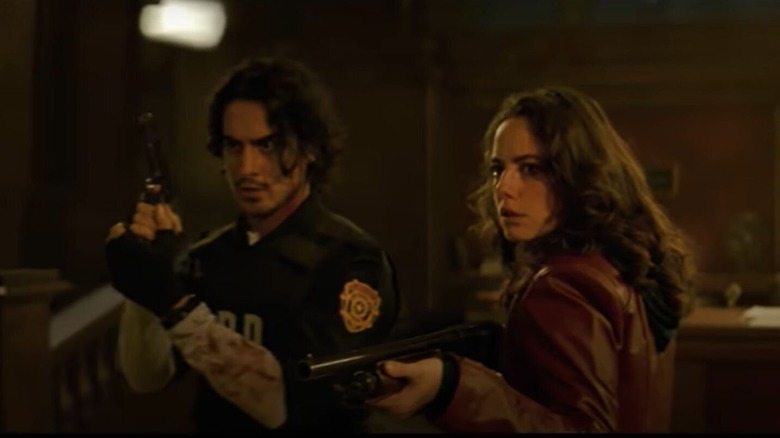Easter Eggs You Missed In Resident Evil: Welcome To Raccoon City
When "Resident Evil: Welcome to Raccoon City" was announced, writer-director Johannes Roberts claimed the reboot would be a faithful adaptation of the original 1990s video games and would contain numerous nods to the source material. Now that the movie is out, we can confirm: he wasn't kidding. While the film takes some creative liberties here and there, condensing the timeline so the events of "Resident Evil" and "Resident Evil 2" occur at the same time and some of the characters are rewritten to fit the new themes of the story, "Welcome to Raccoon City" feels delightfully familiar, particularly for fans of the original games.
In addition to the broad strokes of the story, "Welcome to Raccoon City" is absolutely loaded with nods and references to the games, Easter eggs that enhance the viewing experience for those who have followed the "Resident Evil" games and movies for decades. Here are some of the best Easter eggs we noticed in "Resident Evil: Welcome to Raccoon City." As always, beware of SPOILERS.
Itchy. Tasty
The zombie infection that overtakes Raccoon City doesn't suddenly transform its victims into undead monstrosities; it slowly weakens their brains and deteriorates their bodies until they die and are reborn as shambling flesh-eaters. The original "Resident Evil," released in 1996, features a collectable journal called "Keeper's Diary" that details a character's mental descent into undead madness. They initially complain about feeling itchy all over before their speech pattern becomes simple and barely legible. They describe killing and eating a person, calling him "tasty." Their final journal entry only contains two words: "Itchy. Tasty."
In "Welcome to Raccoon City," Claire Redfield is visiting her brother's house when all hell breaks loose in the quiet mountain town. She is confronted by a woman with a sunken visage who writes, in blood, the words "Itchy Tasty" on the window of the Redfield house. For those who don't know the game, this interaction shows that the zombies are a bit different from how they're traditionally depicted, and have a phase where they're halfway between life and death, capable of articulating their thoughts, but possessing no desires beyond the will to kill and eat their victims. For fans of the game, the words bring back fond memories of one of the most intimate and disturbing scares from the original "Resident Evil."
Bad truck driver
In "Welcome to Raccoon City," Claire Redfield (Kaya Scodelario) is introduced in the passenger seat of an 18-wheel truck, having hitched a ride into Raccoon City. When a woman wanders into the street, the truck driver (Pat Thornton) is too slow to notice and runs her down. This sequence is a nearly shot-for-shot homage to the scene from 2019's remake of "Resident Evil 2," right down to the truck driver's fondness for juicy hamburgers.
After hitting the woman, the man gets out of his truck to investigate, but the zombified woman gets up and walks away from the accident while he's not looking. In the movie, his dog licks up some of the woman's blood, unwittingly infecting itself with the T-Virus, at which point it bites its owner. In the game, however, the truck driver has no dog, and is instead bitten directly by the undead woman. It's also worth noting that the truck driver is a much creepier figure in the movie, since he sexually harasses Claire and then leaves the scene of his truck accident when he should have called the police. In the game, the truck driver never interacts with Claire, who rides into town on her motorcycle.
The mansion zombie reveal
The first zombie ever shown in "Resident Evil" remains one of the most memorable moments in the history of the survival horror genre. The iconic image of a flesh-eating zombie taking a bite out of a S.T.A.R.S. member before slowly turning its attention to the player is seared into the brains of generations of video game enthusiasts. The sequence was recreated in the 2002 "Resident Evil" remake, and now it's been re-recreated for "Resident Evil: Welcome to Raccoon City."
While a faithful recreation of that classic moment, the sequence in the movie loses a bit of its impact since it's not really the first time we see a zombie in "Welcome to Raccoon City," though the zombies in the mansion have progressed further along in their infection than any of the other ones shown in the film up to this point. Still, it's an effective moment showing the extremely detailed makeup on the zombie actors, and a much-appreciated nod to the source material.
HUNK
Agent HUNK made his video game debut in "Resident Evil 2." He briefly appeared in a cutscene when he and his men confront William Birkin, but he became notorious for his role in "The 4th Survivor," an unlockable mode that follows the gas mask-wearing operative as he attempts to escape Raccoon City with limited ammo and healing items. The notoriously difficult mode, featured in both the original and 2019 remake, made HUNK an instant fan favorite, but he's only made sporadic appearances since, usually in non-canon modes like the Mercenaries, and never without his signature face covering.
As Umbrella puts the titular town under lockdown in "Welcome to Raccoon City," a soldier is shown in a costume nearly identical to the one worn by HUNK. It's unlikely he's supposed to be "Mr. Death" himself, but his gas mask and all-black ensemble are clearly meant to evoke Raccoon City's "4th Survivor," so named because he follows Claire, Leon, and Sherry ... Which probably makes Ada Wong the fifth survivor, since she's later revealed to have also survived the events of Raccoon City, to say nothing of the plethora of other survivors shown in games like "Resident Evil 3" and "Resident Evil: Outbreak," but that's a discussion for another time.
Would you rather
Jill Valentine (Hannah John-Kamen) has a wicked sense of humor in "Welcome to Raccoon City." She's introduced drawing her sidearm, seemingly willing to perform a William Tell-esque trick shot on a sleeping Leon Kennedy, much to the chagrin of Wesker, who intended for her to attempt the shot using a child's toy gun; he's visibly disturbed by Valentine's apparent desire to actually shoot a bottle of ketchup off Leon's head ... though she may have been joking. Probably. Hopefully.
Later on, she demonstrates her twisted sense of humor yet again when she ponders the question, "How would you rather die: being swallowed whole by a giant snake, or eaten by a great white shark?" Her S.T.A.R.S. allies are disturbed by the thought, and for good reason: In the original "Resident Evil," both of these ghastly fates can befall Richard Aiken. In Jill's scenario, Richard can be devoured by Yawn, a giant monster snake; in Chris' scenario, he can be torn apart by a Neptune, a great white shark infected with the T-Virus.
Raccoon City Orphanage
"Welcome to Raccoon City" features the Raccoon City Orphanage, where Chris and Claire grew up. The orphanage, particularly its outer gates, looks completely identical to the location seen in the remakes of "Resident Evil 2" and "Resident Evil 3." In those games, like the movie, the orphanage is a front for Umbrella's twisted experiments on innocent, defenseless children. The front gate is adorned with the same artwork in both the movie and the game, even though the location plays a different role in the games.
in the "Resident Evil 2" remake, the location is visited by young Sherry Birkin, who is chased by a more villainous Chief Brian Irons, while "Welcome to Raccoon City" has a less villainous version of Irons (played by Donal Logue) bring Leon and Claire to the orphanage since it contains a secret passage to the Spencer Mansion, another new flourish created for the movie.
Other recreated locations
The orphanage isn't the only video game location recreated for "Welcome to Raccoon City." The original Spencer Mansion has certain rooms that are reproduced with staggering detail, including the stairwell room with all the paintings on the wall, and the piano room and adjoining secret passage. A character even has to play "Moonlight Sonata" on the piano in order to open up the secret room.
On the other side of town, the foyer of the Raccoon Police Department HQ has been fully recreated, though it looks to a layman's eyes more like a digital matte painting than a full-scale set. The S.T.A.R.S. office is similarly reproduced, looking just as it did in the original "Resident Evil 2," and the holding cells, while located in a different part of the building from the original game, look just like the original, right down to the presence of Ben Bertolucci in one of the cells.
First aid spray
The protagonists of the "Resident Evil" video games would be dead a thousand times over if not for their use of first aid spray. This restorative item, ironically manufactured by the Umbrella Corporation, raises the player's health to full and has been used in nearly every "RE" game since the 1996 original. It's unclear exactly how it works, but it seems Umbrella, despite their heinous track record of evil misdeeds, actually does make useful products that help save lives.
Eagle-eyed viewers will notice a fleeting glimpse of first aid spray in "Welcome to Raccoon City." While a physical can of the spray doesn't make an appearance that we noticed, the first scene of the movie, set in the Raccoon City Orphanage, features artwork depicting the healing item. A PSA billboard advertises the product, and the artwork used to represent the can looks exactly like the artwork from the classic games.
The Licker
The Licker first appears in "Resident Evil 2," and has made numerous appearances since then, popping up in "Resident Evil 5" and most of the games set during the Raccoon City outbreak. It also appears in three of the six Paul W.S. Anderson-directed "Resident Evil" movies (1, 2, and 5, for the record), and is one of the most instantly recognizable Resident Evil creatures.
In "Welcome to Raccoon City," only a single specimen is seen, but it leaves a memorable impression. First, it stalks Leon by crawling across the ceiling, evoking the monster's intro from "Resident Evil 2." Then it sneaks up behind Chief Irons, lifting him up and killing him by eviscerating his face. When his body drops to the ground, it resembles the police officer found in a hallway in the remake of "Resident Evil 2," whose face is similarly disfigured due to a Licker attack. Before the Licker has the chance to finish off Leon or Claire, though, it's ambushed by none other than Lisa Trevor, who rips the creature's head apart with her unnatural strength.
The Ashford Twins
Released in 2000, "Resident Evil: Code Veronica" follows up on the events of "Resident Evil 2," with Claire Redfield still searching for her lost brother, Chris. Her journey takes her from Paris to Rockfort Island to Antarctica. Eventually Chris and Claire (and even Wesker) do battle with Alfred and Alexia Ashford, psychotic child prodigy twins who developed the T-Veronica virus. Claire first learns about the Ashford twins when she discovers a film reel showing them as creepy children, with Alfred plucking the wings off of a dragonfly before throwing the helpless bug into a pit of ants, where it is devoured.
This film reel is replicated, almost shot-for-shot, in "Welcome to Raccoon City," with the twins even identified specifically as the Ashfords. There is an edited-in shot of Dr. Birkin watching the creepy kids, implying that they might be from Raccoon, and not one of Umbrella's European branches. Whether the Ashfords' appearance is a mere Easter egg or a hook for a prospective sequel remains to be seen.
Palm Pilot map
The original "Resident Evil" games are akin to mazes, with labyrinthine locations packed with locked doors and tricky puzzles to solve. To help players get around, pausing the game would bring up the map screen, showing the player's location, which doors were locked or unlocked, and which rooms had been explored. While future games would focus more on the action and less on the puzzle-solving, the map remained, allowing players to easily retrace their steps and figure out where to go next.
As part of his betrayal of his fellow S.T.A.R.S. members in "Welcome to Raccoon City," Wesker is given a Palm Pilot portable device with specific instructions and a map of the Spencer Mansion. The map's style looks identical to those found in the early PlayStation "Resident Evil" titles, but in monochrome black and white. Wesker consults the map numerous times and follows the its instructions in order to reach the piano room and open the secret passage to the underground lab beneath the mansion.
Card keys
A big part of the classic "Resident Evil" formula is figuring out how to unlock the numerous doors in any given location, be it the Spencer Mansion, the RPD building, or an underground science lab. Sometimes, tasks need to be performed with Key Items, which usually unlock keys to open specific doors. In "Resident Evil 2," both the original and the remake, four particular keys are coded to the four suits in a deck of cards: Diamond, Spade, Club, and Heart.
"Welcome to Raccoon City" features the same keys, which are used by Claire and Leon to open the underground passage to reach the Spencer Mansion from the Raccoon City Orphanage. The use of these specific keys is a reference to the use of special keys in the games, as well as the puzzle-solving nature of those early titles. The prop keys look identical to their video game counterparts, right down to the colors.
The zombie dog
Nearly every "Resident Evil" game has had some type of canine enemy. In fact, the very first obstacle encountered by the S.T.A.R.S. team in the original 1996 game is a pack of Cerberus, which are Dobermans infected with the T-Virus. Even when the series moved away from the T-Virus, zombie dogs remained, as seen with the Colmillos enemies in "Resident Evil 4," which are dogs infected with the Las Plagas parasite. The zombie dogs were featured prominently in Paul W.S. Anderson's "Resident Evil" movies, appearing in all six films.
There is only one zombie dog in "Welcome to Raccoon City," but it certainly leaves an impression. It belongs to the trucker who accidentally hits a zombie with his 18-wheeler. When the trucker steps out to investigate, his dog follows him and licks up the zombie blood on the road, unwittingly infecting itself with the T-Virus. Upon succumbing to infection, the dog bites its owner, turning him into a zombie. Finally, the dog is seen chasing Chief Irons in the RPD parking lot, and nearly kills him. Fortunately for Irons, Claire shows up in time to crush the feral creature's brain with repeated blows from a fire extinguisher.
Jill Sandwich
The original "Resident Evil" was infamous for its poor voice acting, with badly translated lines delivered by actors who probably didn't have enough time to properly prepare or research their characters. There's no shortage of memetic dialogue that continues to be shared on internet message boards to this day, but perhaps the most famous occurs after Jill is rescued from a room with a collapsing ceiling; after saving Jill from being crushed to death, Barry Burton remarks, "You were almost a Jill sandwich." The line is retooled in the 2002 remake to "A second later, you would have fit nicely into a sandwich," which lacks the punchy humor of the original.
In "Welcome to Raccoon City," Jill and the rest of S.T.A.R.S. are eating dinner at Emmy's Diner (another location lifted from the games) when Jill snatches Wesker's sandwich off his plate before he can take a bite. Before she begins eating, she says, "You snooze, you lose. It's a Jill sandwich now." Later in the movie, she shoots Wesker to death, so he has larger concerns than the sandwich, all things considered.
Costume design
The costumes in the "Resident Evil" video games play a key role in defining the characters who wear them. Especially back in the days of low-polygon 3D models, much effort had to be made to keep the characters distinct. That's why Wesker has his spiky blonde hair and sunglasses, Chris has his sleeves rolled up, Jill has her beret, and Barry has his red vest. As the visuals became more advanced, the characters were redesigned to be more realistic and fashionable, to the delight of some players, and to the chagrin of others who think Claire looked just fine in her pink denim short shorts over short leggings and black shapewear.
Several characters in "Welcome to Raccoon City" dress in a manner that evokes their classic costumes. Claire wears clothes that are nigh-identical to her outfit from the "RE2" remake (no pink denim here, thankfully!), and Chris is dressed just like he did in the original game, with his sleeves rolled up to show off his beefy arms. Likewise, Wesker wears an all-black ensemble, and the post-credits scene gives him his character's signature sunglasses. Said post-credits scene also features the debut of Ada Wong, who wears the same trench coat she sports in the "RE2" remake. Even Leon looks like his classic video game counterpart once Claire instructs him to don a set of RPD body armor.
Missed opportunities
Despite all the nods and references in "Welcome to Raccoon City," there are still some elements that can't help but feel like missed opportunities. Leon is shown firing what looks like an M1911 handgun, when it would have been so easy to give the character his H&K VP70M from "Resident Evil 2," otherwise called the Matilda. Likewise, no mention is made of Robert Kendo or his gun shop, which could have been a nice source of firearm-related Easter eggs.
Jill doesn't wear her beret or chunky shoulder pads, but to be fair, those might look silly in live action. Likewise, maybe it's for the best that no mention is made of Brad Vickers' cowardice, since he already dies a grisly death; why add insult to injury?
Finally, since Raccoon City is nothing more than a crater of debris by the end of the movie, future films will have to take more creative liberties if they decide to implement creatures like Nemesis or Mr X, since those particular monsters are so closely linked with the events of Raccoon City in the game.
